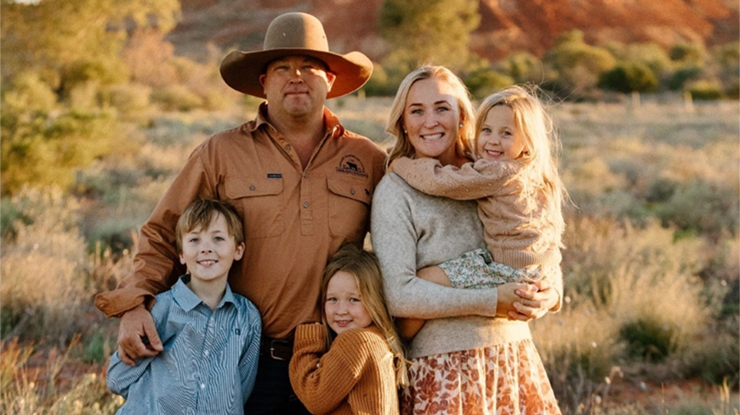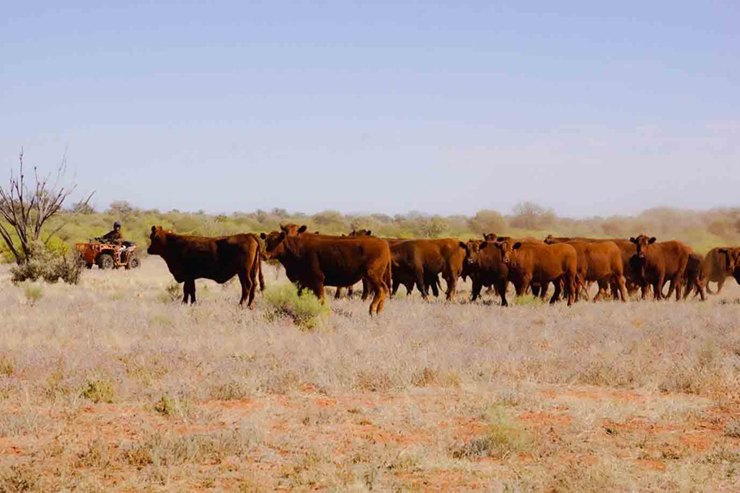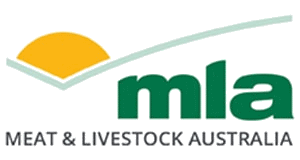Weaner wellbeing sets up future productivity
01 April 2025
 The McKay family. Image: Angus McKay
The McKay family. Image: Angus McKay
A strategic approach to weaner management underpins high standards of cattle health and productivity in the McKay family’s enterprise on the NT/SA border.
Angus (Gus) and Kimberley McKay and their three children manage 820,000ha across two properties – ‘Umbearra’ and ‘Idracowra’. Gus is the third generation of the McKay family on these lands.
They are custodians of diverse terrain – including open granite range country, gum-lined creeks, mulga country, sand hill regions, river plains and flood-out areas.
A rich mix of native and enhanced vegetation supports approximately 11,500 Red Angus-cross cattle, a breed selected for its fertility and Meat Standards Australia (MSA) scoring potential. Umbearra’s average MSA index over the past 12 months was 59.79.
Stocking strategies
The McKays oversee a comprehensive range of cattle operations, from self-replacing breeding programs to turning off heavy steers.
At full capacity, the property supports 2,00 maiden heifers, 4,500 breeders, 120 bulls and 5,000 steers.
Herd numbers are strategically adjusted based on the stock class and land system, all coordinated around essential watering points.
This identified by the carrying capacity of the various land types across the property and the estimated pasture yield. Due to the variability of rainfall in Central Australian, a conservative approach is taken to provide sufficient ongoing feed should there be limited rainfall the following year.
“We run conservative numbers so our stocking rate doesn’t change much due to seasonal conditions,” Gus said.
Trusted advisors
The McKays draw on their 60 years of family experience and expertise in managing Umbearra as well as the advice of rangeland specialists.
Dr Dionne Walsh – an export in the field who runs her own consultancy and has worked for the NT Government in research and consultancy roles around rangeland management – contributes valuable insights into their management decisions and practices.
Chris Materne, Pastoral Production Officer for the NT Government, also brings his extensive experience researching pastures and carrying capacity in rangeland environments to the table when discussing the McKays’ management decisions.
This collaborative strategy has been crucial in optimising the efficiency of the couple’s livestock management.
Markets
The McKays’ cattle are predominantly marketed through abattoirs in Victoria and SA.
The natural advantages of Central Australia, with its expansive natural landscapes, good pasture quality and minimal pollution and parasites, supports organic farming practices.
All mature cattle are processed under an organic label, accredited by both the United States Department of Agriculture National Organic Program (USDA/NOP) and Australian Standards.
They aim to sell this portion of cattle at approximately 24–28 months of age, weighing between 600–700kg.
“Organic certification is pretty easy for us in our environment,” Gus said.
Their primary challenge lies in securing high-quality organic hay and ensuring lick blocks don’t contain any urea. To address this, they have partnered with an organic lick supplier who custom makes their phosphorus lick blocks, ensuring compliance with organic standards while maintaining the health and productivity of their livestock.
The McKays source their phosphorus lick blocks and biochar blocks from Olsson’s Blocks as these don’t contain urea so are able to pass organic certification.

Red Angus cattle at ‘Umbearra’. Image: Angus McKay
Breeder management
The McKays use a two month controlled mating period at Umbearra for their maiden heifers once they reach approximately 300kg at 12–15 months of age.
They use continuous mating after this initial phase.
The heifer conception rate is an average of 86%. Any heifers that are identified as pregnancy tested empty (PTE) after this maiden mating are turned out with the steers, where they are grown to a target weight of 500kg and transported to markets.
The McKays’ weaning strategies enable them to consistently maintain a minimum body condition score of three for both their heifers and cows. This careful management ensures the health and productivity of their livestock and the land, reflecting their commitment to quality and sustainability in their cattle operations.
Weaning
The McKays’ approach to cattle management involves meticulous care of heifers and steers from the weaning stage onward.
At Umbearra, they wean from 200kg (or approximately nine months of age) to allow heifers and cows to regain their body condition before cycling again.
Once in the yards, the weaners are fed organic oaten hay. Due to their organic certification, the McKays are limited to compliant supplements and therefore wean at the higher end of the weight range. This ensures weaners have enough reserves to continue growing well without additional supplementation.
The McKays dedicate a significant amount of time to educating weaners in the yards and tailing them out.
They adopt low-stress stock handling practice both inside and outside the yards at Umbearra, to ensure the wellbeing of their livestock.
Tailing out activities are conducted using motorbikes to allow weaners to be efficiently moved and fed on pasture before being returned to the yards – this also maintains uniformity in mustering practices later on. Additionally, weaners undergo internal yard work and education, which produces animals with good temperaments.
Rings are used to castrate weaner steers. Heifers and steers are branded using a gas fire brand to maintain identification and health records. Umbearra boasts a weaning rate of approximately 90% – a testament to the McKays’ high standards of cattle management and strategic planning.
“We are very happy with our weaning rate – it has taken 22 years of controlled mating to achieve these results,” Gus said.
Mustering
The McKays use water trapping, airplanes, helicopters and motorbikes for mustering. The prevalence of Indigofera, a poisonous plant that can complicate the safe use of horses in the area, has led them to favour motorbikes.
The McKays conduct two full musters annually at Umbearra, in addition to a mid-year pregnancy testing muster for the maiden heifers. The meticulous mustering and weaning practices, along with conservative stocking rates, are key contributors to the property’s high weaning rate, as the females remain in good body condition, enabling a short post-partum anoestrus period and high pregnancy rate.
In addition to their usual mustering practices, the McKays have successfully integrated stress-free stockmanship learnings from Bruce Maynard. This approach prioritises understanding and working with natural behaviours of cattle to minimise stress during handling.
By incorporating these principles, particularly during the critical periods of mustering and tailing out, the McKays ensure a consistent and gentle handling process.
This adaptation approach not only maintains the wellbeing of cattle but also enhances the overall efficiency and safety of operations, which keeps animals calm and responsive. In turn, animals experience less stress when in the yards, allowing for more consistent and efficient daily weight gains.
Data management
The McKays follow the principle of ‘what isn’t measured can’t be managed’.
Their main data-driven areas of focus are fertility and turn-off weights. They use Gallagher crush-side technology and Black Box system to monitor cattle and carcase performance.
All cattle are equipped with a National Livestock Identification System (NLIS) tag to ensure full traceability and electronic data recording. Breeders are also assigned management tags that identify their age, to enhance management and tracking within the herd.
This systematic approach to data collection and analysis is integral to optimising the productivity and sustainability of their livestock operations.


